 |
||
|
||
| ||
 CONTENTS
ASUSTeK Computer's plans about ATI's processors were rumored long ago. One of the facts that added fuel to the fire was that MSI, old NVIDIA's partner, concluded a contract for using ATI's GPUs in its cards. That was written about even in the central mass media like Yahoo. If MSI stepped on this way, why wouldn't ASUSTeK do the same? Although they were just rumors until the official announcement we got one interesting video card: 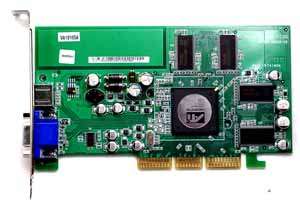 That was RADEON 9000 based card from ASUSTeK. As it was manufactured before the agreement ws concluded, that card sold as a noname card. It's not the first agreement between this companies. You might remember the V264 series produced by the Taiwanese company in 1997 with ATI RAGE, RAGE II+, RAGE II+DVD, and RAGE PRO GPUs onboard. 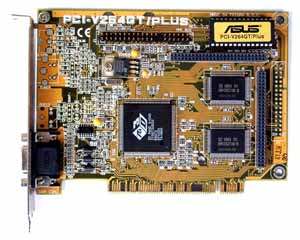 We've got a sample in our museum. In fact, only with the release of the RAGE 128 the Canadian company broke off collaboration with the third manufacturers and focused on its own card production. After such events the Taiwanese electronic King (this is how the guys at ASUSTeK jokingly interpret "TeK" in the company's name) produced everything that was popular (there were even 3dfx Banshee based cards), and then it focused on NVIDIA's cards and remained faithful to it until October 1st this year. 3dfx Interactive's bankrupt helped ATI realize its mistake: 3dfx refused to collaborate with card makers and decided to make its cards itself using the facilities of STB Systems; soon it realized its mistake but it was late. So, ATI started looking for new partners. The brook was very tiny at the beginning
but thanks to the clear-sighted top management and improving drivers the gentle
murmur turned into a roaring river. Meanwhile, NVIDIA made a mistake with its
NV30, and it took it a lot of time to recover. Then ATI released its R300 that
conquered users' hearts (ATI even fell onto its knees before TSMC begging to increase
the lots but the Taiwanese semiconductor giant had very tight schedule).
Theoretical materials and reviews of video cards which concern functional
properties of the GPU
It's obvious that ATI Technologies managed to grasp the technological leadership, though its sales volumes are not the greatest, - it just offers the leading performance of top products. The new race has started. The companies even resort to overclocking and promote overclocked solutions as completely new (the marketers at both companies must have huge wages). Probably, the fact that none of them (ATI or NVIDIA) can be unconditionally considered a leader made ASUSTeK reconsider its faithfulness. The time will show how the marketers at ASUSTeK will divide products of the same class into niches. Right after the release of the RADEON 9800 XT, 9600 XT the Canadian company announced ASUSTeK Partner No1. Does such partnership mean unequal conditions for the its other partners? - We don't know. Taking into account ASUS' facilities and potential, the deliveries to other companies could fell down as it's impossible to increase the volumes with TSMC that fast. So, ASUS got the following products:
I'm not aware if ASUSTeK will use any other processors as well. Such models were chosen probably to prevent the inner competition with NVIDIA based cards. Maybe there are some other reasons. Today we will test the whole line. Note that it's the first time we deal with a card based on the RADEON 9600 XT. Cards
All the cards are based on the reference design which was a bit altered in each case. Unfortunately, we didn't receive yet a reference card on the 9600 XT, that is why I compared it with the RADEON 9600 PRO. The ASUS card differs in the VIVO support. The most powerful card - 9800 XT - follows the reference design, though the RAGE Theater is old, 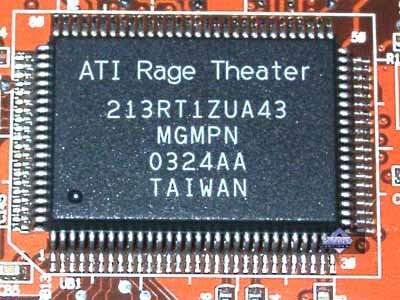 while the reference card is designed for the RAGE Theater 200 (new). The card also supports hardware monitoring. The whole line is painted bright orange. I never saw such cards before. 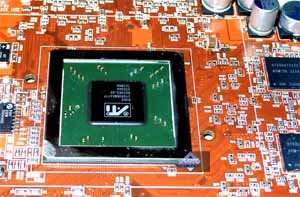 Two cards (9600 XT and 9800 XT) support VIVO thanks to the Rage Theater. I must say that you can find main video operation functions written right on the packages; here's how the box of the 9800 XT looks like: 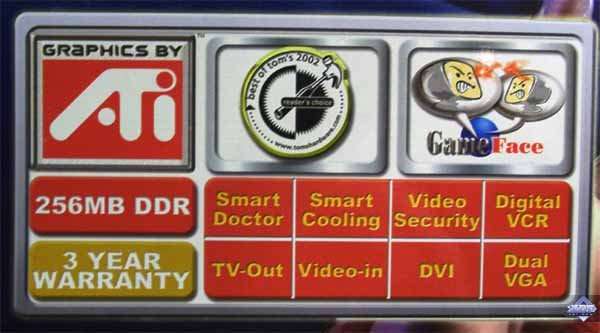 Alexey Samsonov will soon tell you about RAGE Theater (both versions) and its video capturing functions. That is why I'll omit it here. Here is how the RADEON 9800 XT based card looks when inserted into the mainboard: 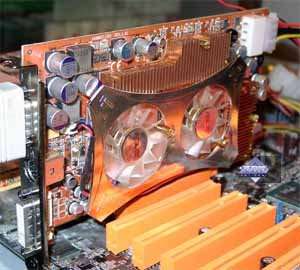 The cooler is pretty low and doesn't prevent installation of cards into the first PCI slot. As to the coolers, the RADEON 9200SE has an ordinary pin heatsink. Have a look at the GPUs: ASUS RADEON 9200SE 128MB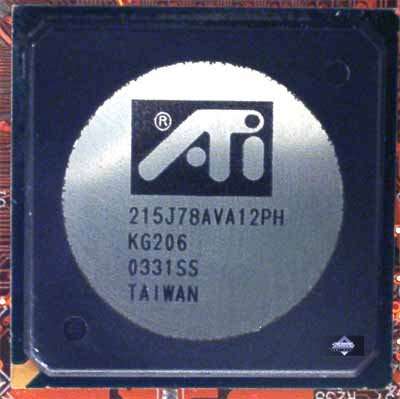 ASUS RADEON 9600SE 128MB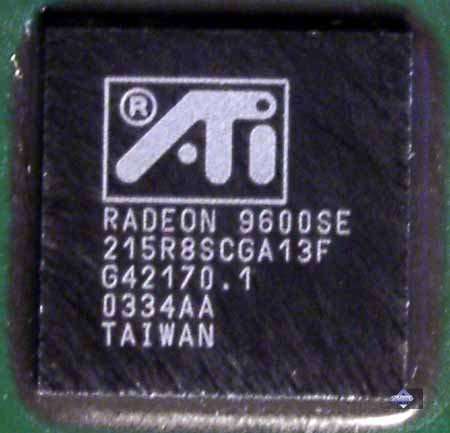 ASUS RADEON 9600 XT 128MB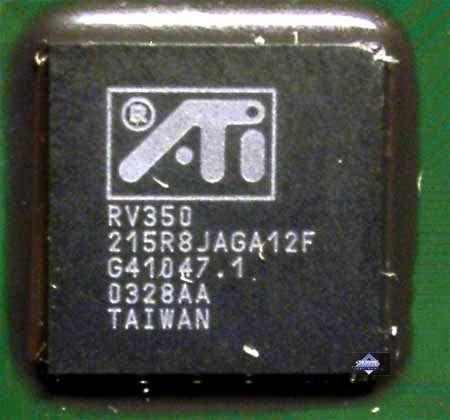 ASUS RADEON 9800 XT 256MB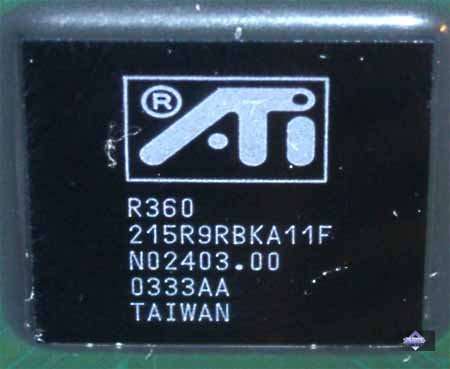 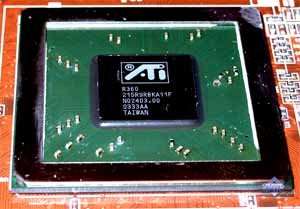 Accessory packs: All the cards ship in retail packages. The RADEON 9800 XT supports hardware monitoring via the ASUS SmartDoctor utility: 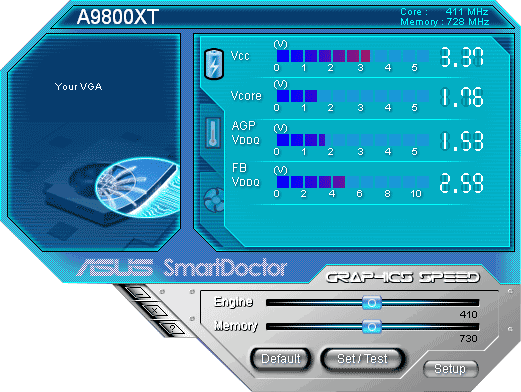 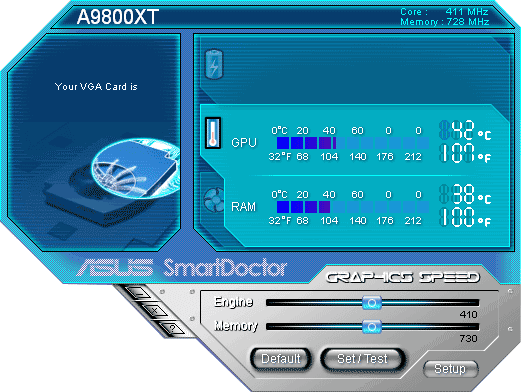 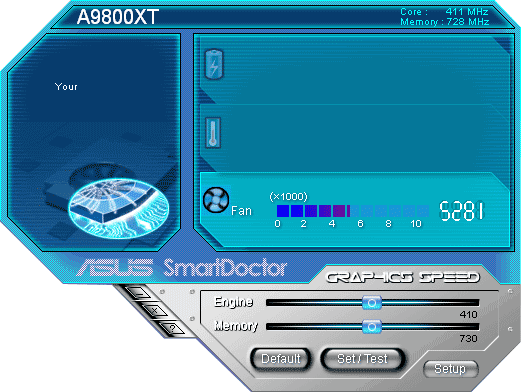 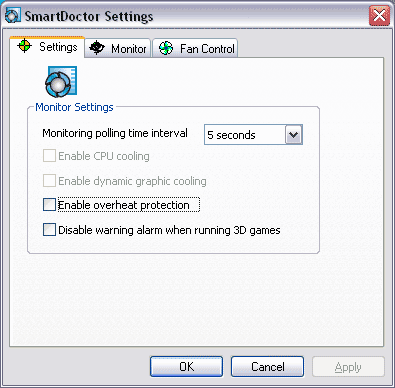 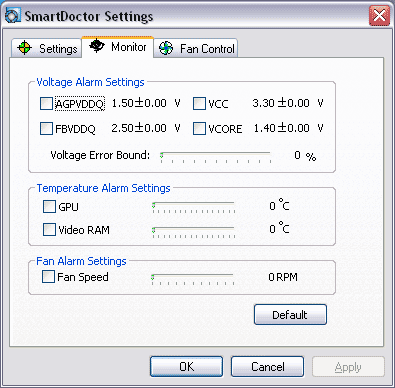 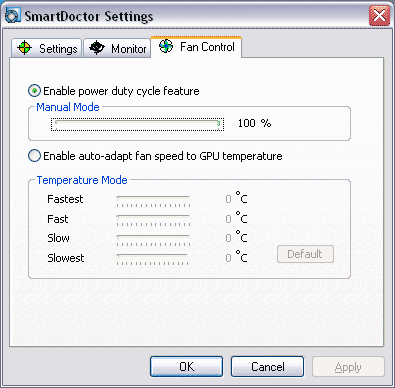 This program doesn't just monitor temperatures and fan speeds, it also allows overclocking the card. The SmartDoctor protects it from burning by controlling the frequencies. The SmartDoctor sets a bit lower core clock - 405 instead of 412 MHz. You can switch to 412 MHz by pressing the Default button. Testbed and driversTestbed:
VSync off, S3TC off in applications. The latest CATALYST 3.8 drivers have several new features including the dynamic overclocking called OVERDRIVE.   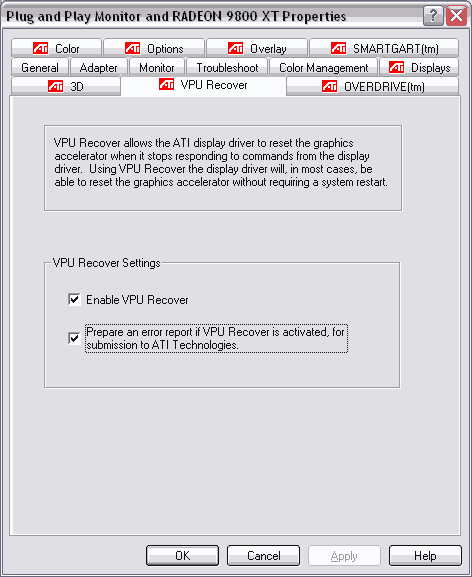 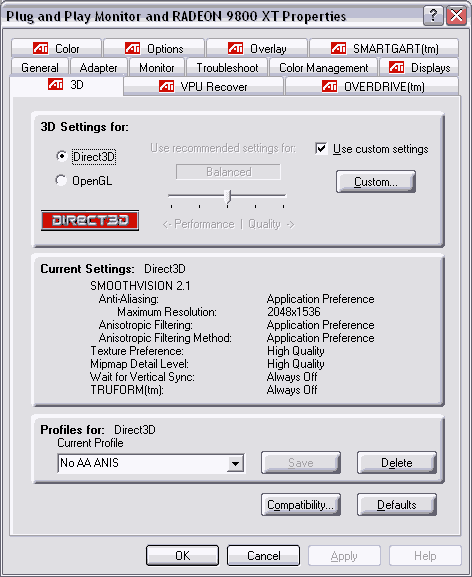 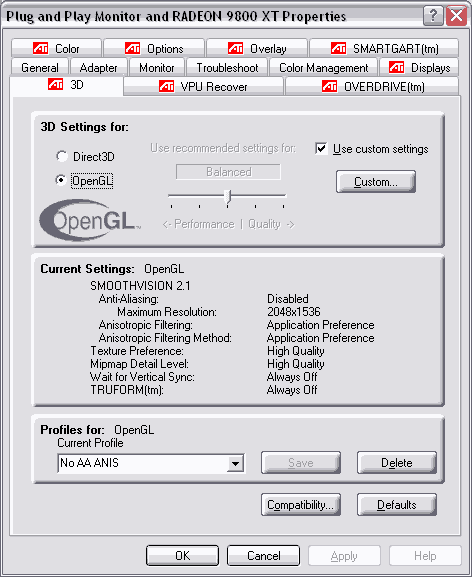 The 3D settings are put into one panel where they are split into D3D and OpenGL branches: 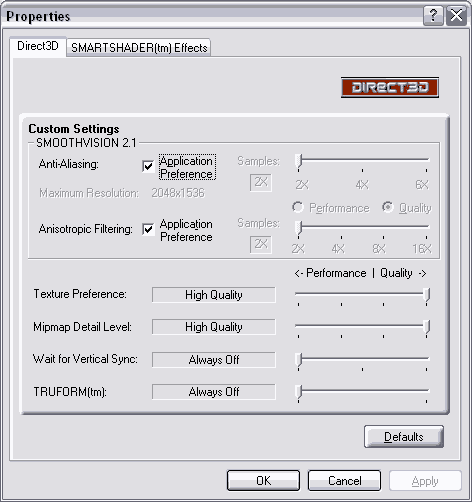 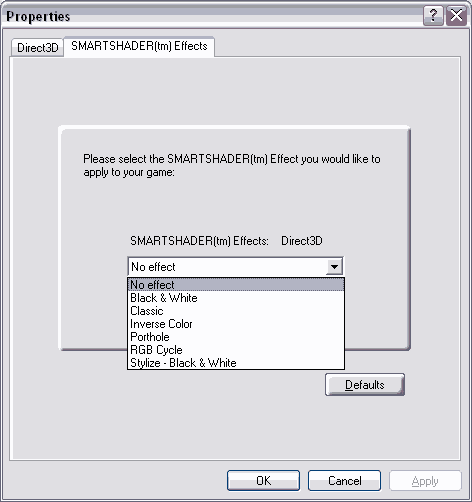 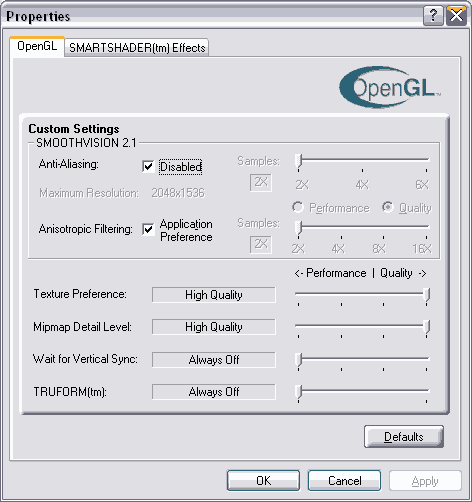 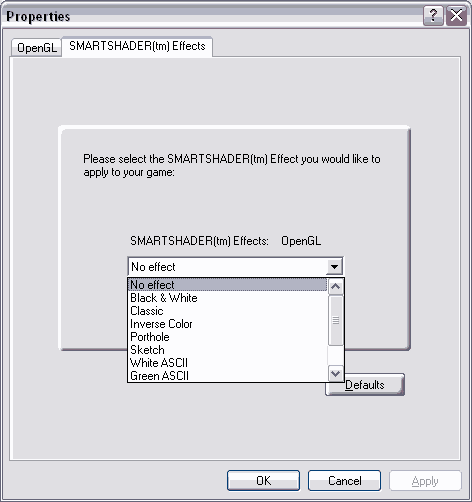 The SmartShader effects will be examined next time. The card is failure protected - the VPU Recover returns the default settings if the card starts working unstably. The most interesting feature is OVERDRIVE. This panel appears only on the reference card; when we installed the same drivers on the ASUS card that tab disappeared. But this function worked by default. Let's use the graphics monitoring of the RivaTuner (by Aleksei Nikolaichuk AKA Unwinder): 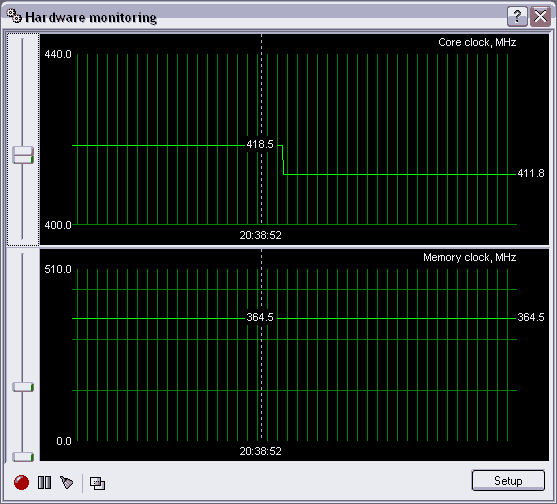 The OVERDRIVE lifts the clock speed to 419 MHz at the beginning. If the GPU gets too warm it cuts down the clock speed to the default values. Actually, at the core temperature up to 52 degrees the card can speed up to 432 MHz; if the temperature is from 52 to 65 degrees, the clock speed is maintained at 419 MHz. Over 65 degrees the clock speed falls down to the default values. Let's try overclocking: 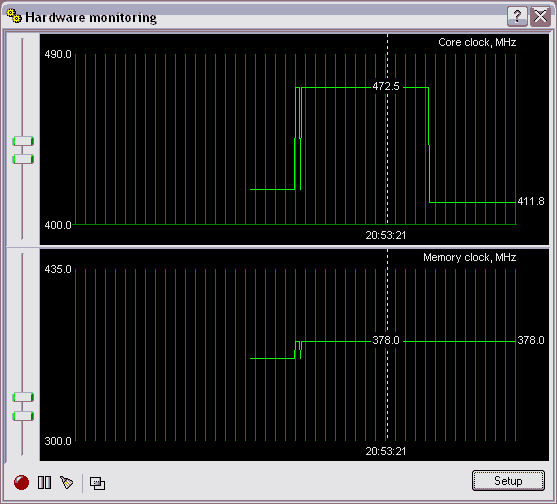 I forcedly set the core clock to 470 MHz leaving the OVERDRIVE enabled. A short time later the clock speed fell down to the default settings because of the failure protection. That's a real progress as the guys at ATI used to assert that end-users didn't need to know such stuff :-). Test resultsBefore we start examining 2D quality, I should say there are no complete techniques for objective 2D quality estimation because:
With the ViewSonic P817 monitor and BNC Bargo cable the cards showed excellent
quality at the following resolutions and clock speeds:
Test results: performanceThe RADEON 9800 XT is compared with the GeForce FX 5900 Ultra based card OVERCLOCKED up to the NV38 clock speed Conventional signs: ANISO 8xP - Anisotropic 8x Performance (earlier it was called Balanced), ANISO 8xQ - Anisotropic 8x Quality, ANISO 16xQ - Anisotropic 16x Quality. Some time ago we decided not to compare ATI's maximum anisotropic quality of 16X to two NVIDIA's modes anymore. The ANISO 8x Quality mode provided the real maximum quality with both trilinear filtering and anisotropy working to their full capacity. The ATI 16x Quality showed sharper images due to the 16th degree but on some surfaces the filtering quality was lower. That's the way ATI's anisotropy works. That is why we thought it was more correct to compare this ATI's mode with NVIDIA's Performance and Quality. But NVIDIA's optimization policy changes the things and we do not know anymore if there are applications where NVIDIA's anisotropy works to its full capacity. That is why we consider that it's correct to compare ANISO 16xQ (ATI) to ANISO 8xQ (NV). Both have their strong and weak points, but in general they compensate each other. Also remember that we compare visual quality, i.e. what we really see. There's no per-pixel comparison as you won't notice difference in quality if it touches just several pixels. Test applications: Return to Castle Wolfenstein (MultiPlayer) (id Software/Activision) - OpenGL, multitexturing, ixbt0703-demo, test settings - maximum, S3TC OFF, the configurations can be downloaded from here Serious Sam: The Second Encounter v.1.05 (Croteam/GodGames) - OpenGL, multitexturing, ixbt0703 demo, test settings: quality, S3TC OFF Quake3 Arena v.1.17 (id Software/Activision) - OpenGL, multitexturing, ixbt0703 demo, test settings - maximum: detailing level - High, texture detailing level - #4, S3TC OFF, smoothness of curves is much increased through variables r_subdivisions "1" and r_lodCurveError "30000" (at default r_lodCurveError is 250 !), the configurations can be downloaded from here Unreal Tournament 2003 v.2225 (Digital Extreme/Epic Games) - Direct3D, Vertex Shaders, Hardware T&L, Dot3, cube texturing, default quality Code Creatures Benchmark Pro (CodeCult) - the game that demonstrates card's operation in DirectX 8.1, Shaders, HW T&L. Unreal II: The Awakening (Legend Ent./Epic Games) - Direct3D, Vertex Shaders, Hardware T&L, Dot3, cube texturing, default quality RightMark 3D v.0.4 (one of the test scenes) - DirectX 8.1, Dot3, cube texturing, shadow buffers, vertex and pixel shaders (1.1, 1.4). Tomb Raider: Angel of Darkness v.49 (Core Design/Eldos Software) - DirectX 9.0, three demo scenes, maximum quality, Depth of Fields PS20 off. The settings are equal for all the cards tested.   If you need patch 49 which is not easy to find and the demo benchmarks
let me know by email.
Quake3 Arena
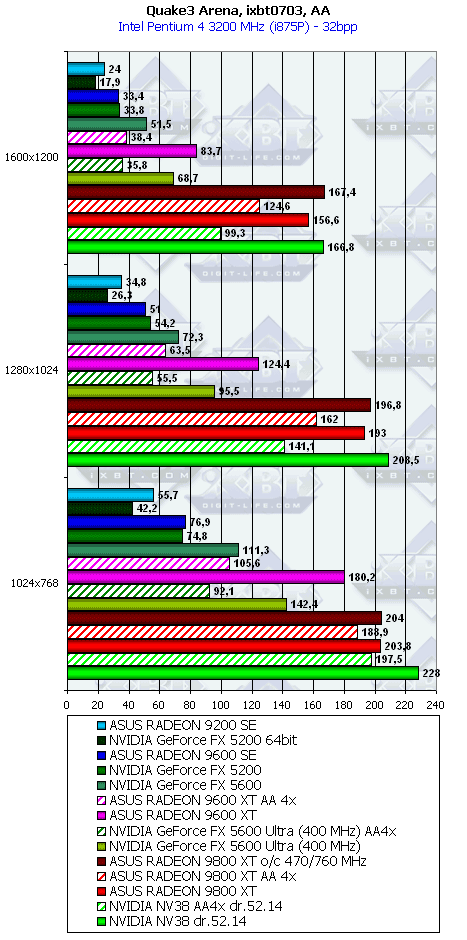 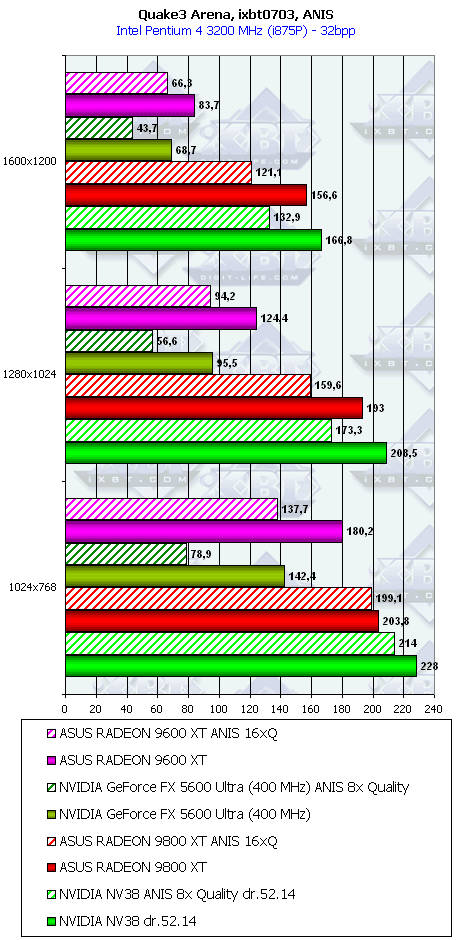 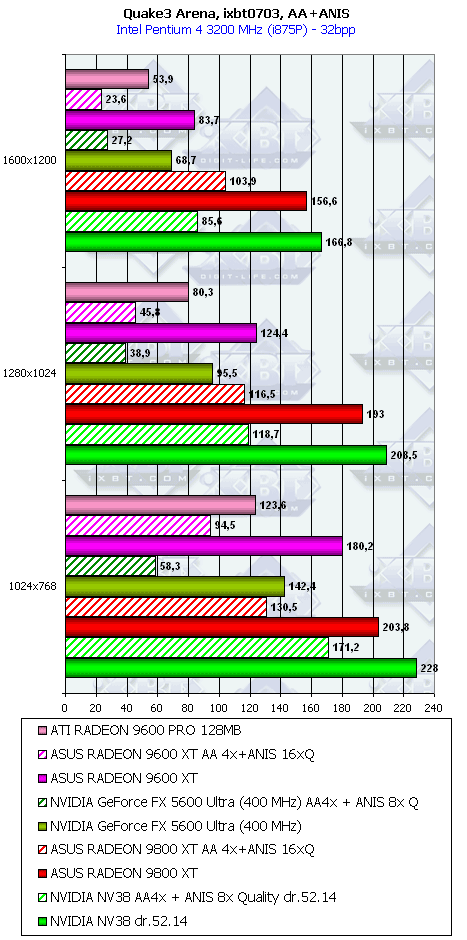 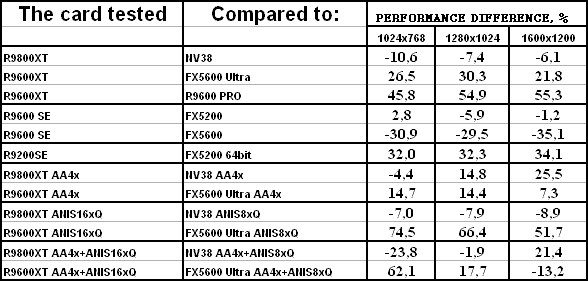 No AA, no anisotropy: the RADEON 9800 XT loses to its competitor. In contrast, the 9600XT wins the battle. This card is also well ahead of the 9600 PRO, though the only difference in the increased core clock. The 9600SE loses to the more expensive FX 5600 (the memory bus is only 64 bits) and loses a little to the FX 5200 (the narrow memory bus makes a fatal effect). The 9200SE easily wins over the FX 5200 64bit. AA enabled: the RADEON 9600/9800 XT is generally ahead. Anisotropy enabled: The 9800 XT loses the battle, while the 9600 XT is a real success. AA & anisotropy enabled: as the resolution grows up the 9800 XT performs better (NV38 loses because of the too narrow memory bandwidth), the competition of the 9600 XT and FX 5600U looks entirely different. So:
No complaints about the quality. Serious Sam: The Second Encounter
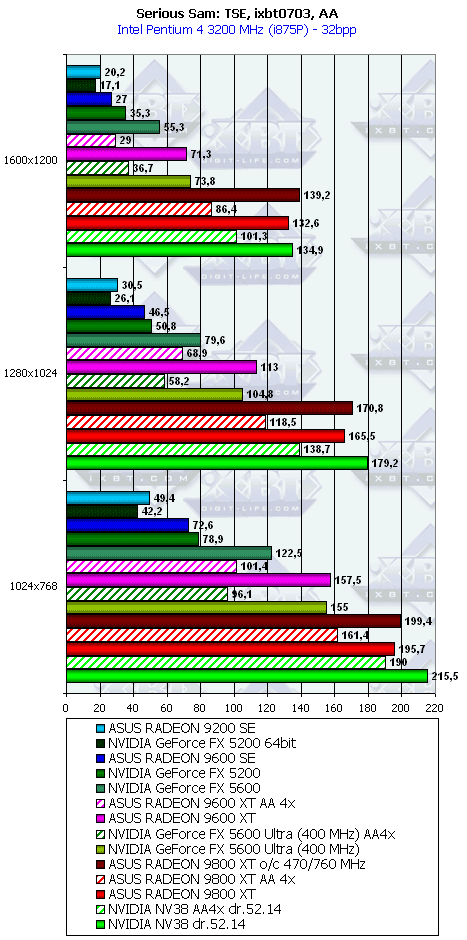 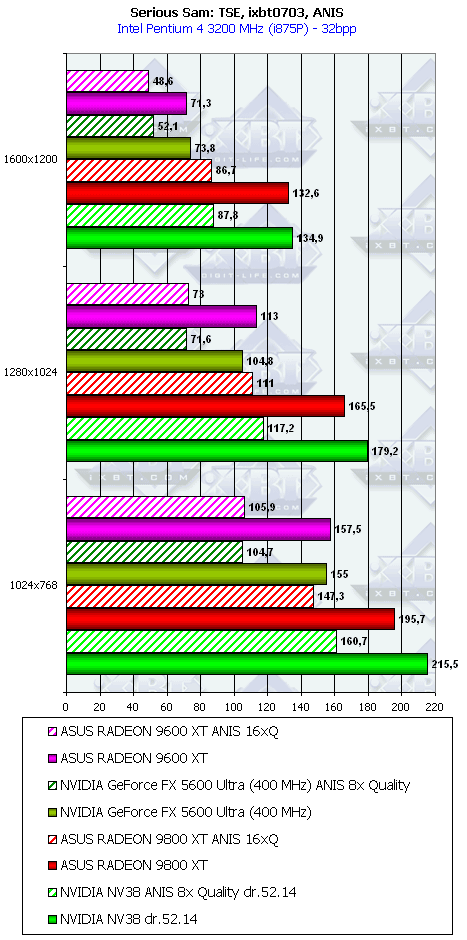 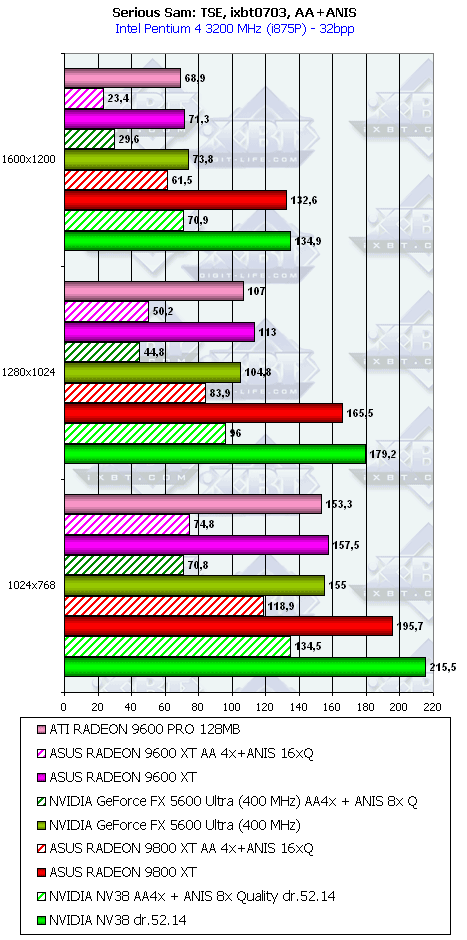 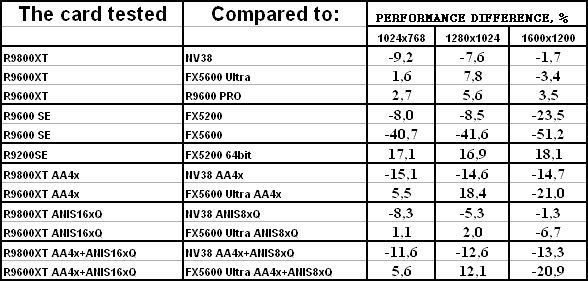 No AA, no anisotropy: the RADEON 9800 XT loses to its competitor. The 9600XT also loses in high resolutions, though the competition is more of less equal. This card is limited by the memory bus, that is why it doesn't increase the scores compared to the 9600 PRO. The 9200SE easily wins the battle, while the 9600 SE has no chance to win here. AA enabled: the RADEON 9800 XT falls behind, the 9600 XT also loses in high resolutions because of the memory bus. Anisotropy enabled: the cards fall back. AA & anisotropy enabled: it's only the 9600 XT among all the RADEONs that takes a lead in low resolutions. So:
No complaints about the quality. Return to Castle Wolfenstein (Multiplayer)
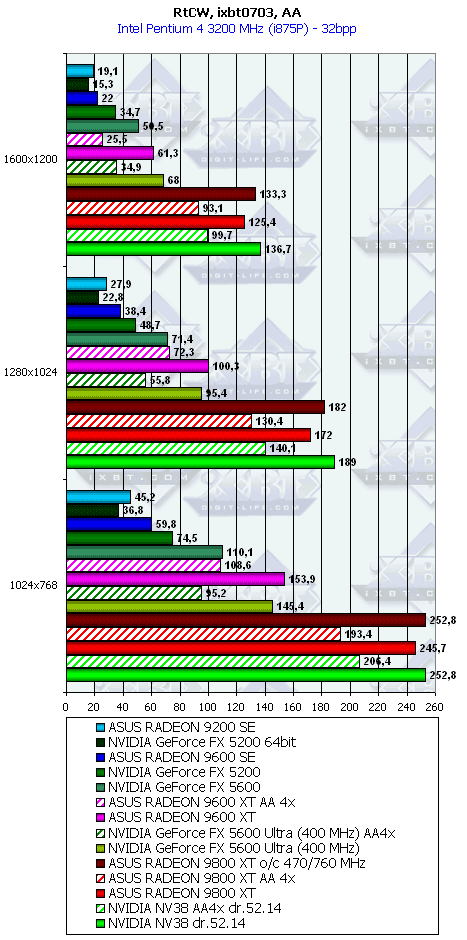 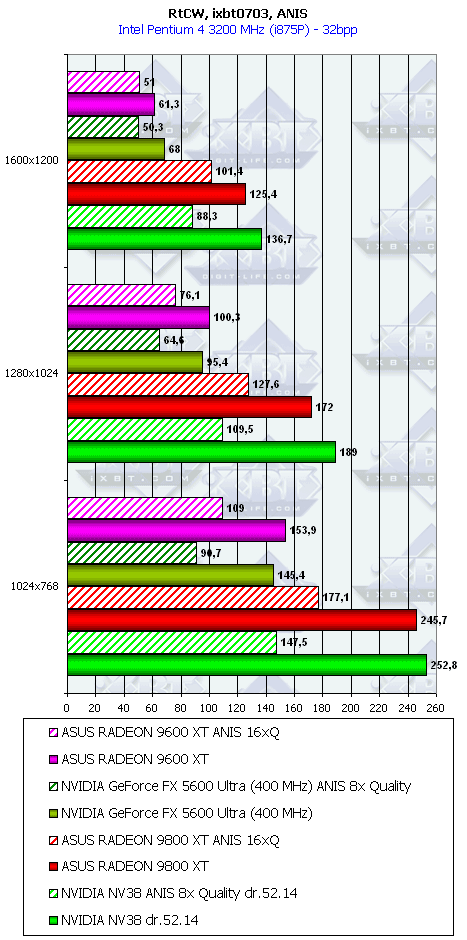 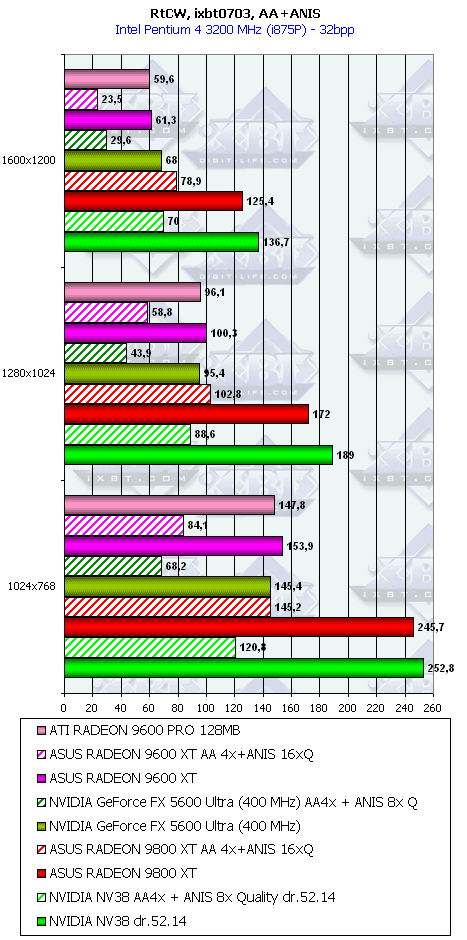 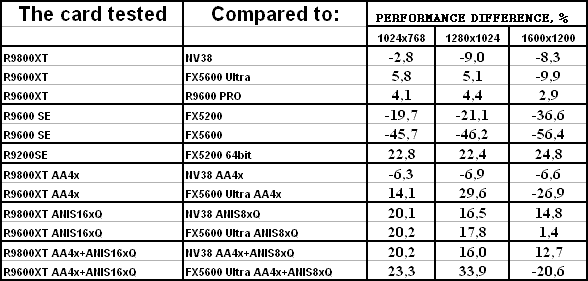 No AA, no anisotropy: the RADEON 9800 XT falls a little behind its competitor, but all GeForce FX cards have bugs on the driver versions 5x.xx (52.xx inclusive). That's why it's hard to judge. I just want to say that the 9600 SE has no chance to win, and the 9600 XT is again limited by its memory bus and doesn't look better than the 9600 PRO. The 9200SE still wins the battle. AA & anisotropy enabled one by one and together: the RADEONs take the lead. So:
The bugs in the NVIDIA drivers are not corrected yet. Code Creatures
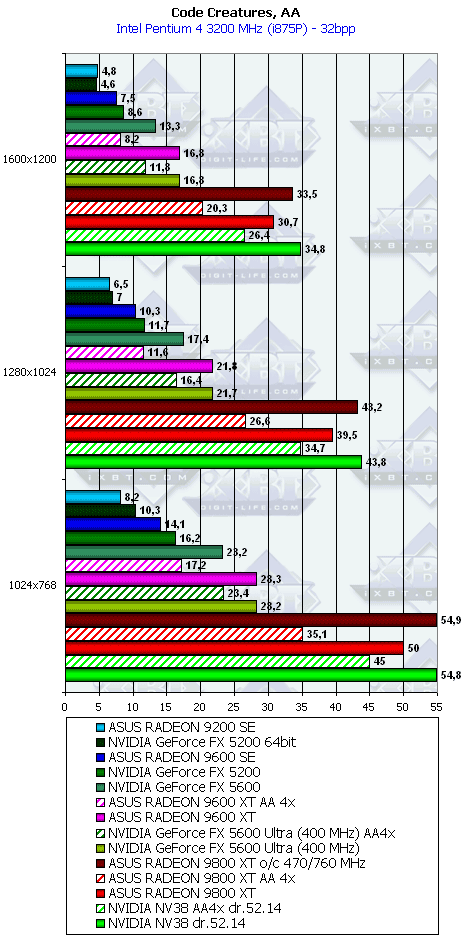 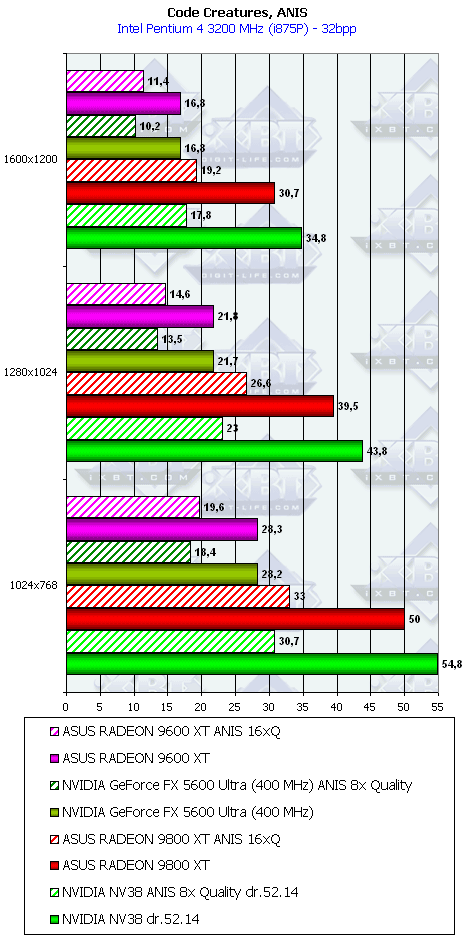 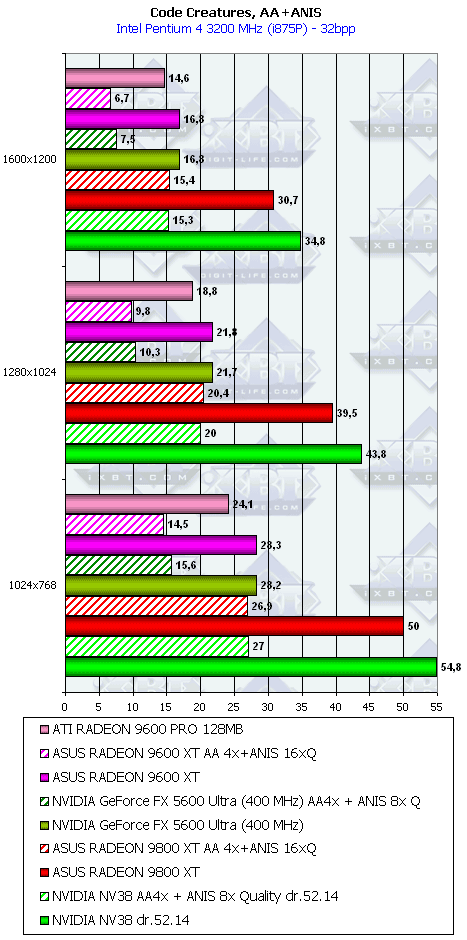 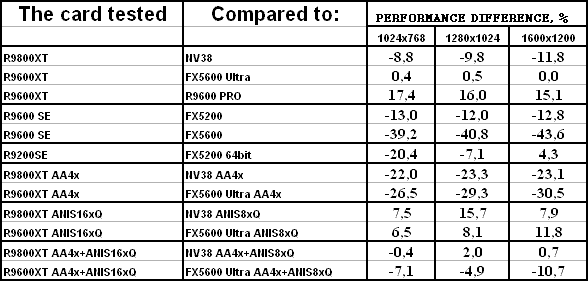 No AA, no anisotropy: the RADEON 9800 XT loses to its competitor. The 9600XT goes on a par with its counterpart. In this test the shader speed makes a greater effect, that its why its crippled memory bus doesn't affect so much, and the card runs faster than its predecessor 9600 PRO. The 9600SE, as well as the 9200 SE (its shader speed is much lower than that of the FX 5200) work bad. AA enabled: no good news from the RADEON camp. Anisotropy enabled: the 9800/9600 cards win this time. AA & anisotropy enabled: 9800 XT catches up with its competitor while the 9600 XP falls back. So:
There's some difference in the images shown by the RADEON and GeForce based cards, but we can't consider one or the other better or worse. Tastes differ. NVIDIA demonstrates optimizations in rendering (probably, ATI has them as well), but no visual bugs are noticed. Unreal Tournament 2003
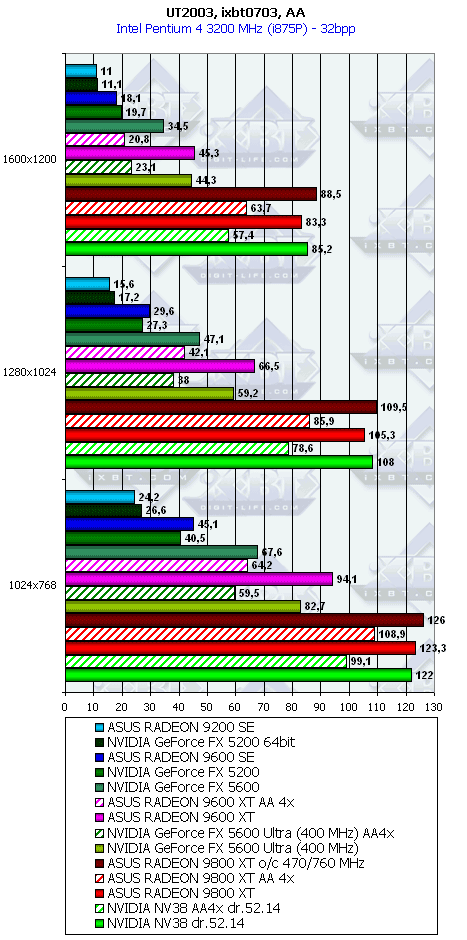 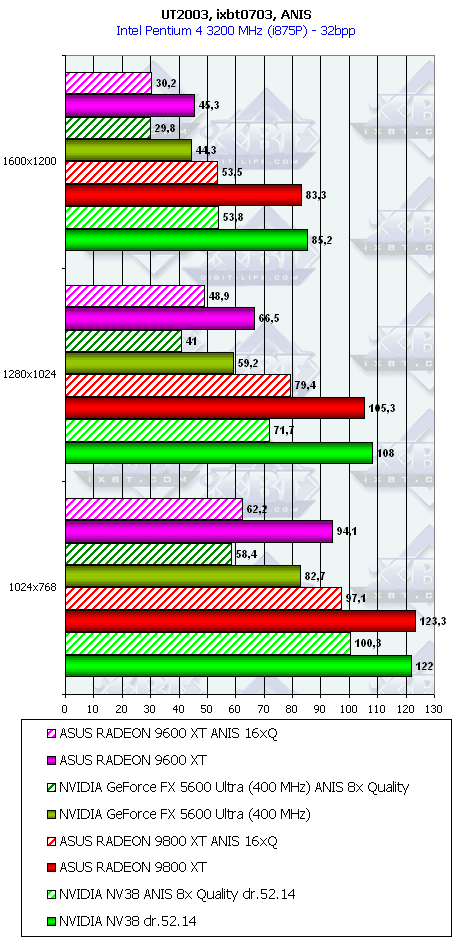 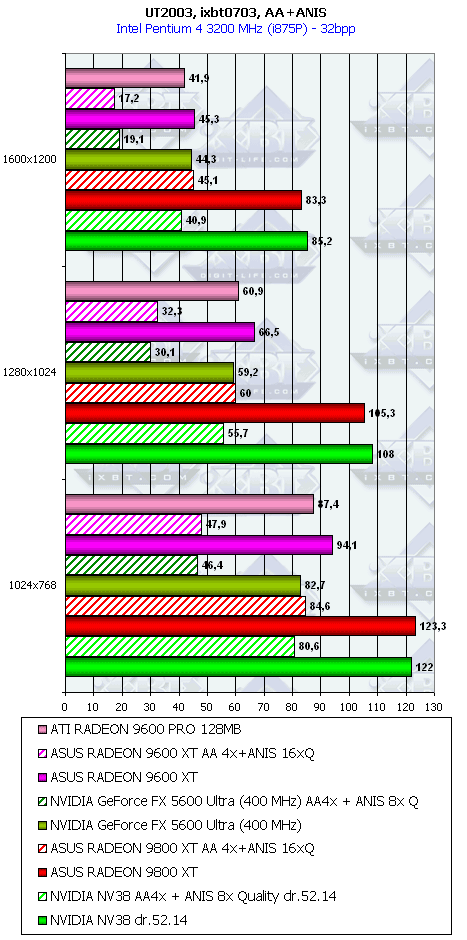 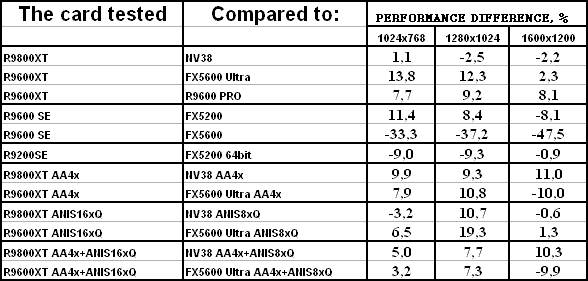 No AA, no anisotropy: the RADEON 9800 XT and NV38 are generally equal. The 9600XT wins the battle. Although it wins over the 9600 PRO the growth by 8% at the core clock difference of 100MHz shows that the performance much depends on the memory bus. The future of the 9600SE will depend on its price. The 9200 SE doesn't perform well. AA enabled: the RADEONs perform pretty well except the 9600 XT which is limited by its memory bus. Anisotropy enabled: the 9800XT both wins and loses, while the 9600XT gain a victory. AA & anisotropy enabled: all the RADEONs are a success, though the 9600XT loses in 1600X1200. So:
No complaints about quality. Unreal II: The Awakening
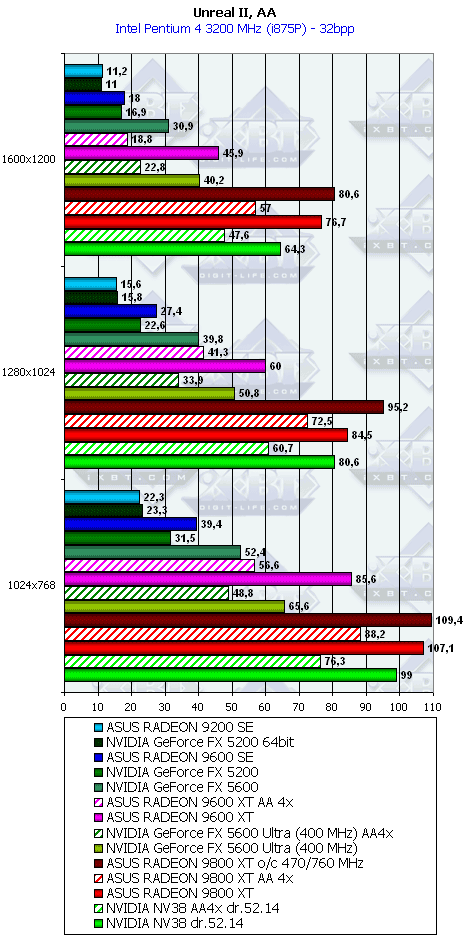 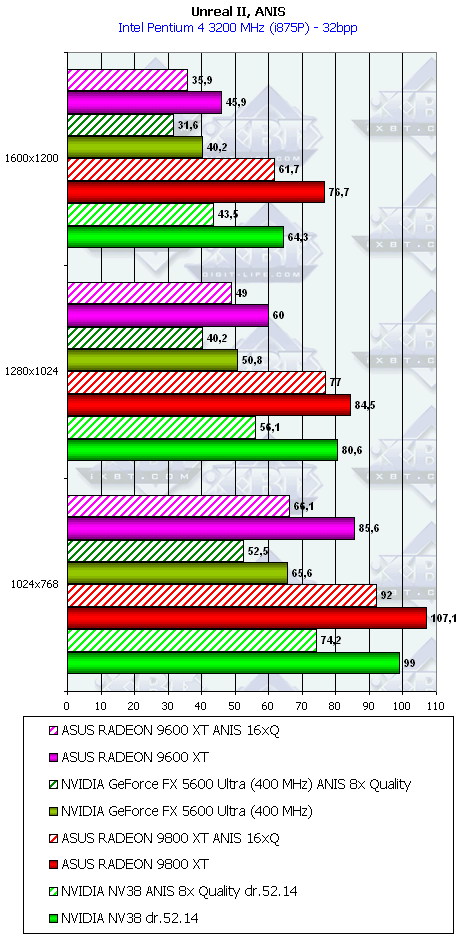 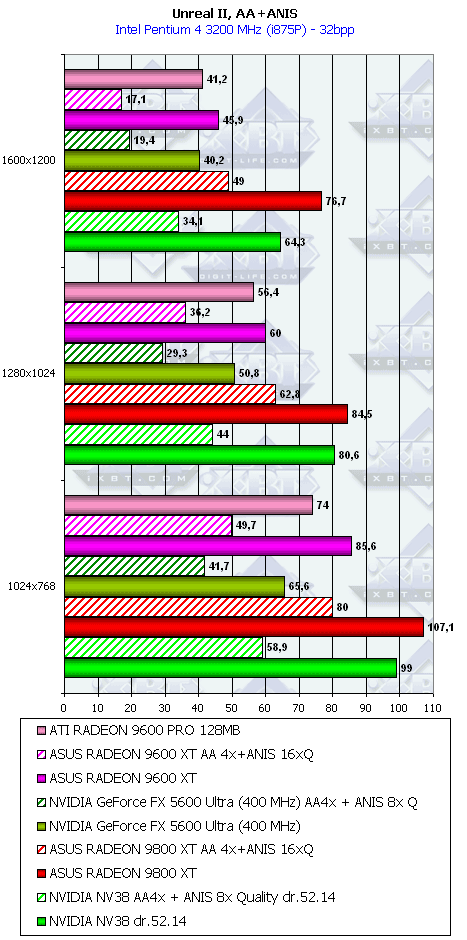 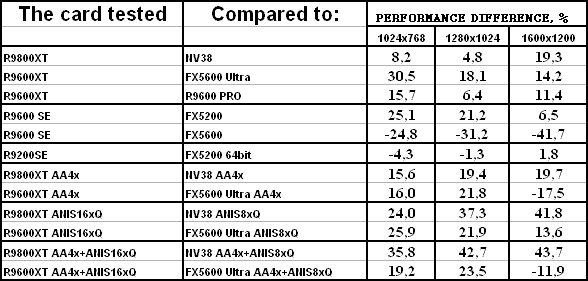 No AA, no anisotropy: all the RADEONs win except the 9200 SE which goes on a par with the competitor. The 9600 XT wins over the 9600 PRO as the core clock is much more influential than the memory bus. The 9600 SE loses to the FX 5600, but its price is also higher. The FX 5200 is also beaten that is why the price will decide a lot. AA enabled: the RADEONs win except the 9600XT which loses in 1600x1200 because of the memory bus. Anisotropy enabled: the cards sweep the field. AA & anisotropy enabled: the picture is the same as in the AA mode. So:
In the RADEON 9800 XT review I mentioned the problems the GeForce FX had in this game with the driver 51.75. Let's compare it to the driver 52.xx:
The situation definitely looks better, the problem is solved. RightMark 3D
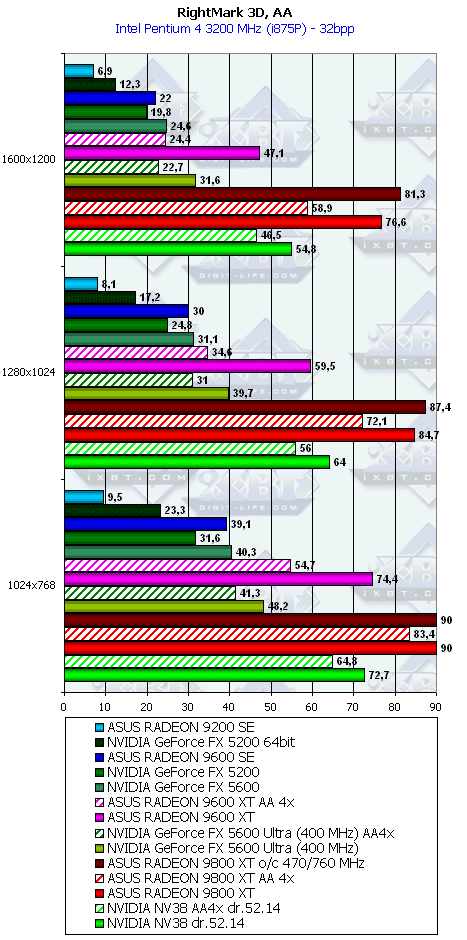 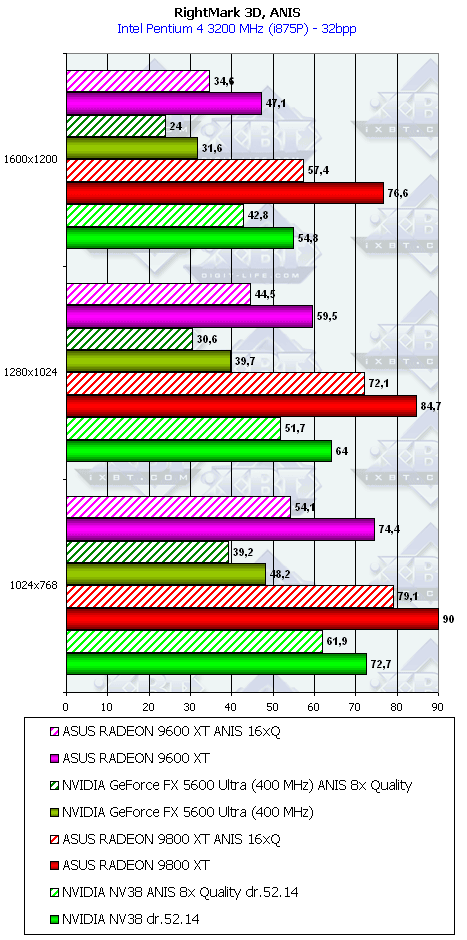 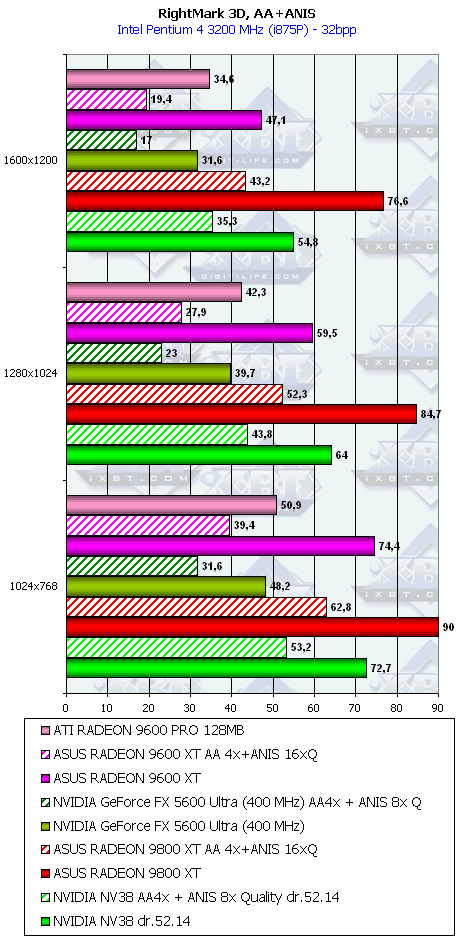 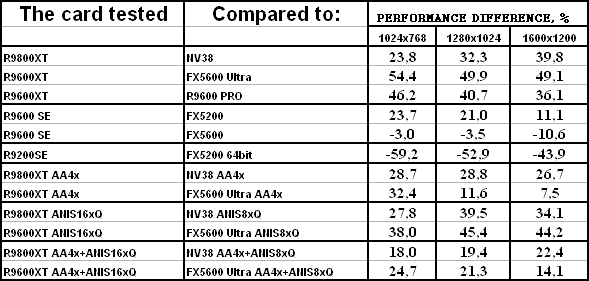 AA & anisotropy enabled and disabled: the RADEONs (all except 9200SE) win in all tests, though not that perfectly as the last time. So:
Look at the bugs in this test with the ATI driver 3.8! The programmers are already informed about it, and we hope that the next time it will be corrected. However, judging by the previous tests where we had no complaints about the quality, the RADEONs except the 9200SE look superior. TR:AoD, Paris5_4 DEMO
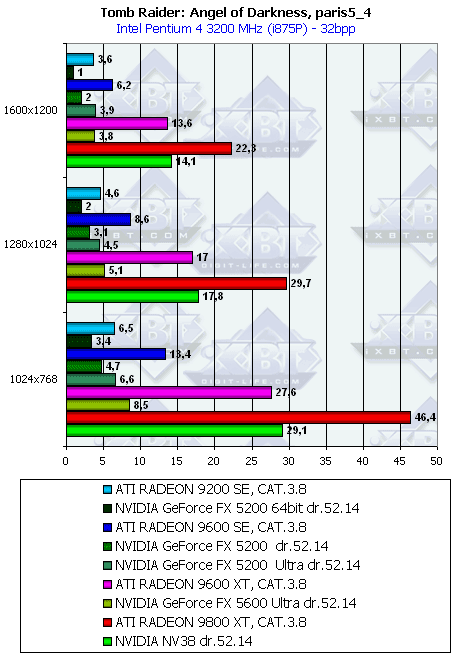  Well, where shaders 2.0 are used 2.0, ATI firmly holds the crown. So:
Quality was already examined, and next time we will add more about it. TR:AoD, Paris1c DEMO
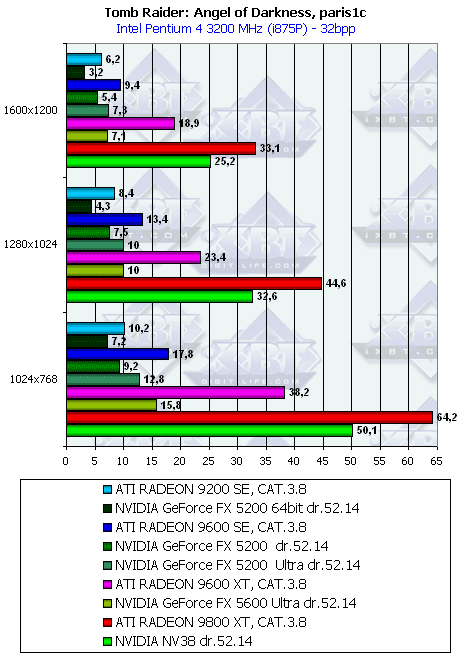  The test uses fewer shaders, that is why the breakaway is not that great. So:
Quality was already examined, and next time we will add more about it. TR:AoD, Paris2g DEMO
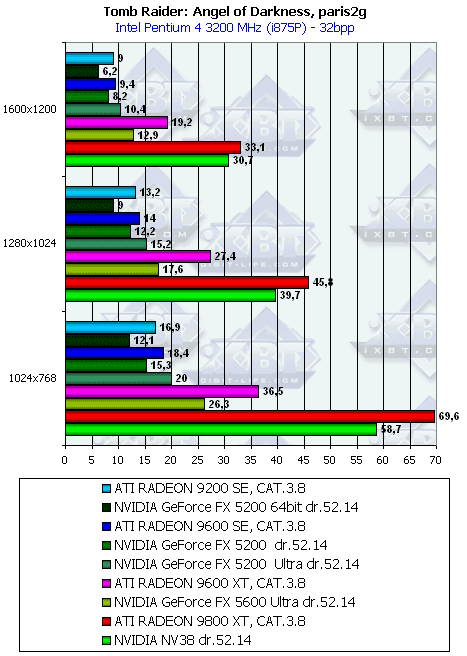  No AA, no anisotropy: This benchmark uses few shaders, the GeForces are close on the heels. So:
Quality was already examined, and next time we will add more about it. HALO: Combat Evolved
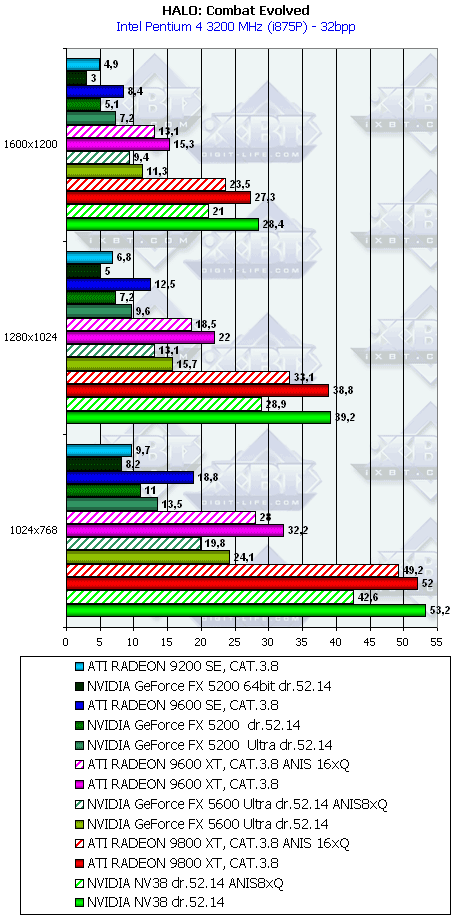  No AA, no anisotropy: the RADEON 9800 XT falls a bit behind, while the 9600 XT is a real success. The others look perfect as well, but remember that the 9200SE doesn't support shaders 2.0, and it used only v1.4 (DX81). But it doesn't affect the quality. Anisotropy enabled: the cards ASUS win the victory. So:
This game doesn't support AA.
The quality on examples 1 and 2 is flawless. But we can see differences between ATI and NVIDIA cards quality on example 3. There are missing lights in the NVIDIA images. AquaMark3This time we tested only two most powerful accelerators: RADEON 9800 XT and NV38 because of some technical problems. 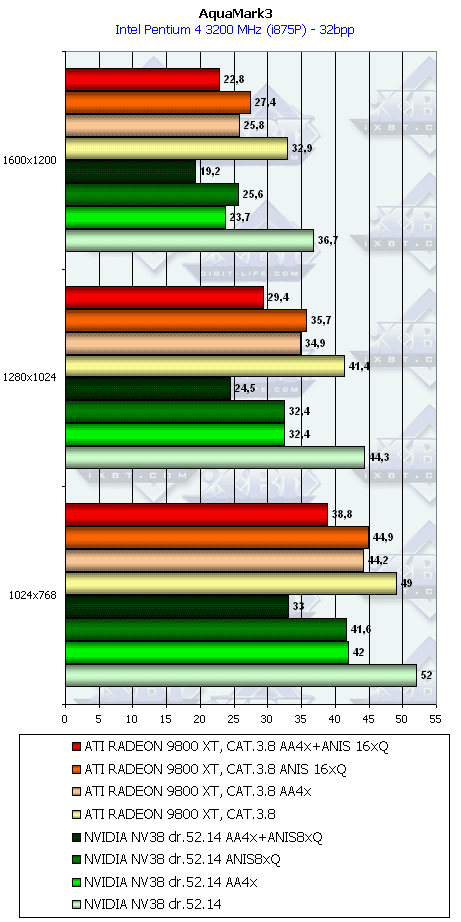  No AA, no anisotropy: the RADEON 9800 XT loses to its competitor. AA enabled: the RADEON 9800 XT wins. Anisotropy enabled: the same. AA & anisotropy enabled: WINNER! So: ASUS RADEON 9800 XT 256MB is a leader (though I can hardly admit that such performance is playable). Some testers mentioned flaws in quality in this test with the first versions of NVIDIA's drivers 5x.xx. This time the rendering quality looks equal. I do not except any optimizations or changes in the driver operation, but from the user's point of view there is no difference in quality. ConclusionSo, ASUSTeK entered the market with a new series of video cards based on ATI's GPUs for the niche of $50 to $500. The price gaps in this line are filled up with NVIDIA based cards. Also note that we expanded the list of the test tools and carried out the more thorough and complete examination of speed and quality of the cards in 3D. Finally, it's the first time we deal with the newcomer on the middle-end market - RADEON 9600 XT.
It obviously beats the 64bit 5200 card. If the price is lower $100, the card will have a chance to succeed.
It looks stronger than the FX 5600 Ultra, but NVIDIA will soon release its
new solution for the middle-end market, that is why the key battle is yet to come.
The RADEON 9800 XT looks a new 3D king. But remember that we used the overclocked NV35 as the NV38, and we don't have yet the final driver version 5x.xx. That is why the tests will continue and I think by the end of fall it will be clear what comes out a leader, though the parity is also possible. All the cards tested have excellent built quality! In our 3Digest you can find full comparison
characteristics for video cards of this and other classes. 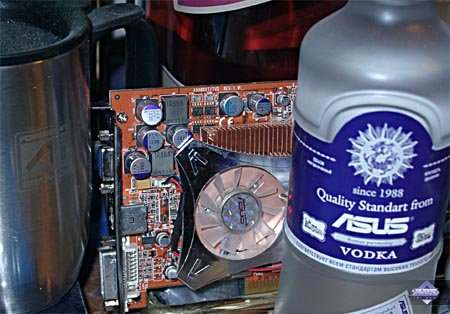
Write a comment below. No registration needed!
|
Platform · Video · Multimedia · Mobile · Other || About us & Privacy policy · Twitter · Facebook Copyright © Byrds Research & Publishing, Ltd., 1997–2011. All rights reserved. | |||||||||||||||||||||||||||||||||||||||||||||||||||||||||||||||||||||||||||||||||||||||||||||||||||||||||||||||||||||||||||||||||||||||||||||||||||||||||||||||||||||||